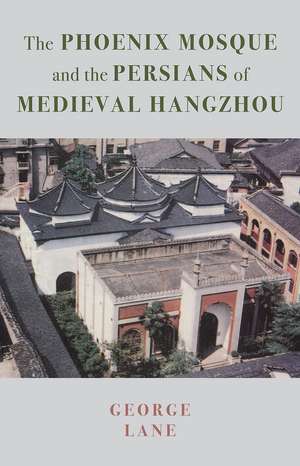The Phoenix Mosque and the Persians of Medieval Hangzhou: Persian Studies Series of the British Institute of Persian Studies (BIPS)
Editat de George A. Lane Contribuţii de Qing Chen, Alexander Morton, Florence Hodous Traducere de Charles Mevilleen Limba Engleză Hardback – 14 feb 2019
In the early 1250s, Möngke Khan, grandson and successor of the mighty Mongol emperor, Genghis Khan, sent out his younger brothers Qubilai and Hulegu to consolidate his power. Hulegu was welcomed into Iran while his older brother, Qubilai, continued to erode the power of the Song emperors of southern China. In 1276, he finally forced their submission and peacefully occupied the Song capital, Hangzhou. The city enjoyed a revival as the cultural capital of a united China and was soon filled with traders, adventurers, artists, entrepreneurs, and artisans from throughout the great Mongol Empire—including a prosperous, influential, and seemingly welcome community of Persians. In 1281, one of the Persian settlers, Ala al-Din, built the Phoenix Mosque in the heart of the city where it still stands today. This study of the mosque and the Ju-jing Yuan cemetery, which today is a lake-side public park, casts light on an important and transformative period in Chinese history, and perhaps the most important period in Chinese-Islamic history. The book is published in the Persian Studies Series of the British Institute of Persian Studies (BIPS) edited by Charles Melville.
Preț: 330.81 lei
Preț vechi: 435.15 lei
-24% Nou
Puncte Express: 496
Preț estimativ în valută:
63.30€ • 66.10$ • 52.27£
63.30€ • 66.10$ • 52.27£
Carte disponibilă
Livrare economică 25 martie-08 aprilie
Preluare comenzi: 021 569.72.76
Specificații
ISBN-13: 9781909942882
ISBN-10: 190994288X
Pagini: 276
Ilustrații: 52 halftones
Dimensiuni: 152 x 229 x 28 mm
Greutate: 0.57 kg
Editura: Gingko Library
Colecția Gingko Library
Seria Persian Studies Series of the British Institute of Persian Studies (BIPS)
ISBN-10: 190994288X
Pagini: 276
Ilustrații: 52 halftones
Dimensiuni: 152 x 229 x 28 mm
Greutate: 0.57 kg
Editura: Gingko Library
Colecția Gingko Library
Seria Persian Studies Series of the British Institute of Persian Studies (BIPS)
Notă biografică
George Lane is a Senior Teaching Fellow in History of the Middle East and Central Asia at the School of Oriental and African Studies (SOAS), University of London. His publications are on a wide variety of topics ranging from women in the Islamic world to notables and rulers in Ilkhanid Iran, and from cities in the Middle East to trade along the Spice Route and Silk Road. Qing Chen is a graduate of SOAS, University of London. Her field of studies is Islamic art and archaeology, with special research interest in the development of Islamic communities, practices and culture in China. Alexander (Sandy) Morton (1942-2011) was educated at Oxford, and after working at the British Institute of Persian Studies (BIPS) in Tehran he began his PhD at SOAS in London under Professor Ann Lambton. A Director of BIPS, Alexander Morton’s influence in his field remains wide and strong.
Recenzii
A most fascinating book. . . .The twenty-one tombstones featured in this book were erected to the memory of real people, all of whom had come from the far quarters of the Mongol Empire to make their fortunes in China. They come alive today in this book, providing readers with a scholarly yet accessible account of how Hangzhou (or Khinsai as the Persians knew it) became a major Islamic center in China, not just of religion or trade but of culture as well. . . .This book is, in the end, not a narrow specialist production, but an opening door into a fascinating culture.

